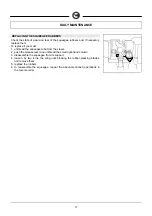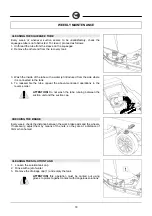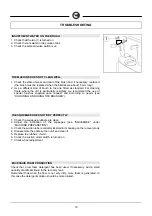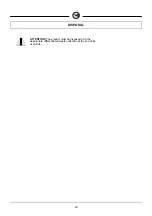
8
GENERAL SAFETY REGULATIONS
The regulations below must be carefully followed in order to avoid harm to the operator and damage to the machine.
U
Read the labels on the machine carefully. Do not cover them for any reason and replace them immediately if
they become damaged.
U
The machine must be used exclusively by authorised, trained personnel
U
During the working of the machine, pay attention to other people and especially to children
U
The power supply cable outlet must have an earth connection in compliance with the regulatory standards.
U
With the brush working do not touch or step over the cord. Avoid damage by crushing, bending or stress
U
If the power supply cable is found to be damaged, the machine must be stopped, if it is operating, remove the
plug from the power supply and have the cable replaced immediately by a COMAC service centre
U
Do not mix different types of detergent as this may produce harmful gases
U
Do not place any liquid containers on the machine
U
The storage temperature must be between -25
°
C and +55
°
C
U
Conditions of use: room temperature between 0
°
C and 40
°
C with relative humidity between 30 and 95%
U
The machine must not be used or stored outdoors
U
Do not use the machine in an explosive atmosphere
U
Do not use the machine as a means of transport
U
Do not use acid solutions that could damage the machine and/or harm people
U
Avoid working with the brushes when the machine is standing still, so as to avoid damage to the floor
U
Do not vacuum inflammable liquids
U
Do not use the device to collect dangerous powders
U
In the event of a fire, use a powder extinguisher. Do not use water
U
Do not hit the racks or structures where there is risk of objects falling
U
Adapt the speed to the adhesion conditions
U
Do not use the machine on surfaces with an inclination greater than the one shown on the plate.
U
When the machine is parked, disconnect the power supply cable from the socket and engage the parking brake
U
The machine is designed to carry out the washing and drying operations simultaneously. Different operations
should only be carried out in areas where the passage of unauthorised persons is prohibited. Signal the
presence of damp floors with suitable signs
U
If the machine does not work properly, check this is not caused by failure to carry out routine maintenance.
Otherwise, request the intervention of the
COMAC
technical service
U
If you need to replace any components, request the ORIGINAL spare parts from a
COMAC
dealer and/or
Authorised Retailer
U
Use only original
COMAC
brushes indicated in the paragraph “CHOOSING AND USING THE BRUSHES"
U
Act quickly on the emergency brake in the event of danger
U
For all cleaning and maintenance interventions, disconnect the machine from the power supply
U
Do not remove any protection devices which require the use of tools in order to be removed
U
Restore all electrical connections after any maintenance interventions.
U
Do not wash the machine with direct water jets or with pressurised water, nor with corrosive substances
U
After every 200 hours of operation, have the machine checked by a
COMAC
assistance centre
U
To prevent the formation of scale in the solution tank filter, do not fill the tank with detergent solution many
hours before using the machine
U
Before using the machine, check that all the hatches and covers are positioned as shown in this Use and
Maintenance Manual
U
Before removing the recovery tank, check it is empty
U
When disposing of consumption materials, observe the laws and regulations in force
U
When your
COMAC
machine has reached the end of its long working life, dispose of the materials it contains
(especially oils, batteries and electronic components) in an appropriate manner, and bearing in mind that the
machine itself was constructed using 100% recyclable materials.








































